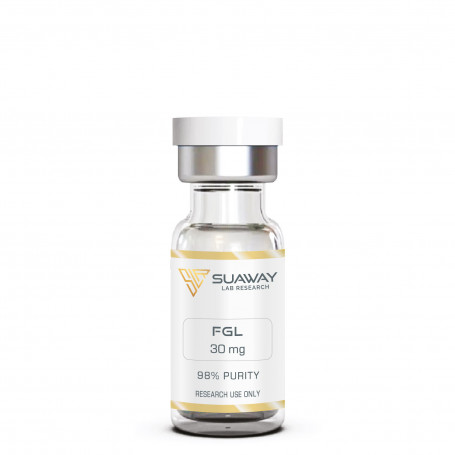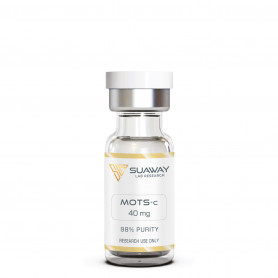FGL - 30 mg
The creation of synapses between neurons, which enhances synaptic plasticity and neuronal growth, is facilitated by FGL. This, together with greater synaptic communication, indicates that FGL may aid in information encoding, leading to better learning and memory. According to research, FGL has the following effects:
- Neuroprotective advantages
- Improved cognitive function
- Traumatic brain injury treatment
- Protection against neurotoxic effects
- Improved memory
- Improved learning
- Alzheimer's disease treatment and cognitive decline
- Improvements in neuroinflammation
- Antidepressant features
- Improving excitatory synaptic transmission
Beschreibung
STRUCTURE
Sequence: pGlu-Val-Tyr-Val-Val-Ala-Glu-Asn-Gln-Gln-Gly-Lys-Ser-Lys-Ala
Molecular Formula: C71H116N20O25
Molecular Weight: 1631.81 g/m
Peptide purity: Greater than 98%
Other details: No TFA Salt, No Mannitol
Storage: Lyophilized peptide must be stored at -20°C and peptide solution at 4°C.
FGL has low oral and excellent subcutaneous bioavailability
DESCRITPION
FGL, short for "Fibroblast Growth Loop," is a little peptide formed from the neural cell adhesion protein that has neurotrophic characteristics (NCAM). The glycoprotein NCAM is present on the surface of glial cells and neurons (protect neurons). As a result of NCAM's activation of FGL, growing neurons produce more new projections.
Additionally, FGL contributes to the establishment of synapses between neurons, which enhances synaptic plasticity or neuronal growth. This, together with greater synaptic communication, indicates that FGL may aid in information encoding, leading to better learning and memory. FGL becomes a significant peptide with the potential to cure a variety of disorders affecting cognitive function when neuronal cell protection and preservation are taken into account.
A review found that NCAM activates brain development pathways by attaching to fibroblast growth factor receptors (FGFRs). FGL replicates NCAM's action in binding to the FGFRs as an FGFRs agonist. FGL stimulates the signaling pathways controlled by FGFRs while interacting with them. Synaptic connections are strengthened by this stimulation thanks to a process related to memory and learning.
FGL improves the activity-dependent distribution of receptors to synapses, improving synaptic transmission, claims a review. It is noteworthy that FGL does not result in naturally improved synaptic transmission. Instead, only in response to synaptic activity does the peptide encourage long-term potentiation (LTP). Nearly twice as much long-term potentiation occurs in the part of the brain that received FGL treatment as in the unaffected regions.
This activity-dependent property is crucial because peptides that significantly boost synaptic transmission run the risk of overstimulating the brain and causing seizures. The FGL peptide aids in the effective encoding of information, leading to enhanced memory, by increasing synaptic transmission solely in response to synaptic activation. This implies that the FGL peptide may be especially helpful in treating diseases like Alzheimer's disease (AD) and depression, which have poor synaptic transmission.
A review found that FGL improves memory in mice by increasing synaptic transmission. FGL enhances several memory and learning processes after being administered subcutaneously to animal models, including fear memory, spatial memory, or motor learning. Improved spatial memory, in particular, may persist for up to two weeks following FGL treatment.
The FGL peptide not only improves several types of memory but also guards against stress-related deterioration of spatial memory. The injection of FGL during the 4 weeks of continuous stress may reportedly stop the negative effects of chronic stress on spatial memory, according to research on rats exposed to chronic stress. These results imply that FGL could be helpful in the management of cognitive impairment.
Even though the precise causes of AD are not entirely known, experts think that the inability of the brain's proteins to function properly, which disrupts brain cells and sets off harmful processes, is to blame. The development of amyloid-beta (A), which affects neurons and interferes with cell communication, is one of the factors that are the subject of intense inquiry. The memory-controlling portion of the brain is harmed by such a sequence of incidents.
A review found that injecting rats with A causes the animals to exhibit symptoms like AD and to have impaired memory. FGL administration, however, may halt the development of these negative effects in the same individuals. Additionally, after receiving FGL, A-injected rats have reduced amyloid plaques and enhanced memory compared to control animals.
Brain plasticity, or the brain's capacity to adapt to learn new knowledge and abilities, is an important function of the NCAM. On the other hand, depression development has a significant correlation with brain plasticity. The research found that giving FGL to NCAM-deficient mice may reduce the symptoms of depression. FGL may also increase the survival of freshly generated neurons when administered repeatedly. According to the research, depression-like symptoms are caused by a lack of NCAM in mice, which FGL may treat.
As was already said, many individuals could be worried about the possibility that overstimulating the brain might result in serious occurrences like epilepsy. Despite this, recent studies have shown that the FGL peptide has few adverse effects. Following intranasal dosages of FGL up to 200 mg for 8 days, a trial with 24 healthy male volunteers found no safety issues. Only a tiny proportion of individuals had moderate, temporary side effects including watery eyes and unpleasant nasal feelings.
The blood-brain barrier is broken down by FGL, which then acts in the brain. FGL is a naturally occurring fibroblast growth factor receptor agonist that stimulates FGFR1 signaling pathways, enhancing neurite outgrowth and survival and thereby improving memory.
Additionally, it has been shown that FGL accelerates neural tissue regeneration by reducing oxidative stress-induced cell death and preventing neuronal degeneration and death.
This fibroblast growth factor (FGL) is directly producible and expressed in glial cells. So once again, it is enhancing the fibroblast growth factor, which is an issue since growth factors enhance neural sprouting.
It seems to be acting very selectively on these brain cells, and it significantly reduces inflammation in the hippocampus region, which is where memories are kept. Additionally, it could have a particularly positive impact on hippocampal repair and hippocampus inflammation reduction, which may be a major factor in certain Alzheimer's cases.
FGL also has a neuroprotective effect by enhancing glial cells, which function as the brain's purging system.
The enhancement of synaptic transmission via a specific biochemical cascade seems to be FGL's principal claim to fame.
AMPA receptors, which are proteins that recognize chemical signals at synapses, were more easily transported to a cell's surface. Additionally, this takes place during a procedure known as long-term potentiation (LTP), a mechanism that is widely known to underlie memory and learning in the hippocampus. FGL may thus enhance and restore cognitive function by enhancing the availability of AMPA receptors and by activating the PKC pathway.
The study has revealed that FGL has the following advantages:
- Increased release of neurotransmitters
- Remyelination of nerves: aids in mending the myelin sheaths that have been damaged surrounding the nerves in multiple sclerosis.
- Synaptogenesis stimulation
- Increased synaptic transmission over time in hippocampal neurons
- improved healing after spinal cord damage
- accelerates healing from a stroke by reducing neuroinflammation levels and fostering remyelination
- Effects of neuroprotection in the management of traumatic brain injury
REFERENCES
F.F. Cox et al., "The neural cell adhesion molecule-derived peptide, FGL, attenuates lipopolysaccharide-induced changes in glia in a CD200-dependent manner" [PubMed]
R. Klein et al., "The synthetic NCAM mimetic peptide FGL mobilizes neural stem cells in vitro and in vivo" [PubMed]
T. Secher et al., "Effect of an NCAM mimetic peptide FGL on impairment in spatial learning and memory after neonatal phencyclidine treatment in rats" [PubMed]
M.V. Pedersen et al., "The synthetic NCAM-derived peptide, FGL, modulates the transcriptional response to traumatic brain injury" [ScienceDirect]
N.J. Corbett et al., "Amyloid-beta induced CA1 pyramidal cell loss in young adult rats is alleviated by systemic treatment with FGL, a neural cell adhesion molecule-derived mimetic peptide" [PubMed]
D. Asua et al., "Peptides Acting as Cognitive Enhancers" [PubMed]
R. Klein et al., "The Neural Cell Adhesion Molecule-Derived (NCAM)-Peptide FG Loop (FGL) Mobilizes Endogenous Neural Stem Cells and Promotes Endogenous Regenerative Capacity after Stroke" [Europe PMC]
B. Ojo et al., "A neural cell adhesion molecule-derived peptide, FGL, attenuates glial cell activation in the aged hippocampus" [PubMed]
S.R. Wainwright et al., "The neural plasticity theory of depression: assessing the roles of adult neurogenesis and PSA-NCAM within the hippocampus" [PubMed]
C. Chu et al., "NCAM Mimetic Peptides: Potential Therapeutic Target for Neurological Disorders" [PubMed]
J.L. Neiiendam et al., "An NCAM-derived FGF-receptor agonist, the FGL-peptide, induces neurite outgrowth and neuronal survival in primary rat neurons" [PubMed]
G. Dallérac et al., "The neural cell adhesion molecule-derived peptide FGL facilitates long-term plasticity in the dentate gyrus in vivo" [PubMed]
C. Zellinger et al., "Impact of the neural cell adhesion molecule-derived peptide FGL on seizure progression and cellular alterations in the mouse kindling model" [ACS Publications]
C.A. Turner et al., "Neural cell adhesion molecule peptide mimetics modulate emotionality: pharmacokinetic and behavioral studies in rats and non-human primates" [PubMed]
S. Knafo et al., "Facilitation of AMPA receptor synaptic delivery as a molecular mechanism for cognitive enhancement" [PubMed]
E.J. Downer et al., "A synthetic NCAM-derived mimetic peptide, FGL, exerts anti-inflammatory properties via IGF-1 and interferon-gamma modulation" [PubMed]
G.G. Skibo et al., "A synthetic NCAM-derived peptide, FGL, protects hippocampal neurons from ischemic insult both in vitro and in vivo" [PubMed]
Y. Chen et al., "The fibroblast growth factor receptor (FGFR) agonist FGF1 and the neural cell adhesion molecule-derived peptide FGL activate FGFR substrate 2alpha differently" [PubMed]
A.Anourm-Helm et al., "NCAM-mimetic, FGL peptide, restores disrupted fibroblast growth factor receptor (FGFR) phosphorylation and FGFR mediated signaling in neural cell adhesion molecule (NCAM)-deficient mice" [PubMed]
A.Anourm-Helm et al., "Depression-like behaviour in neural cell adhesion molecule (NCAM)-deficient mice and its reversal by an NCAM-derived peptide, FGL" [PubMed]
DISCLAIMER
This product is intendend for lab research and development use only. These studies are performed outside of the body. This product is not medicines or drugs and has not been approved by the FDA or EMA to prevent, treat or cure any medical condition, ailment or disease. Bodily introduction of any kind into humans or animals is strictly forbidden by law. This product should only be handled by licensed, qualified professionals.
All product information provided on this website is for informational and educational purposes only.












